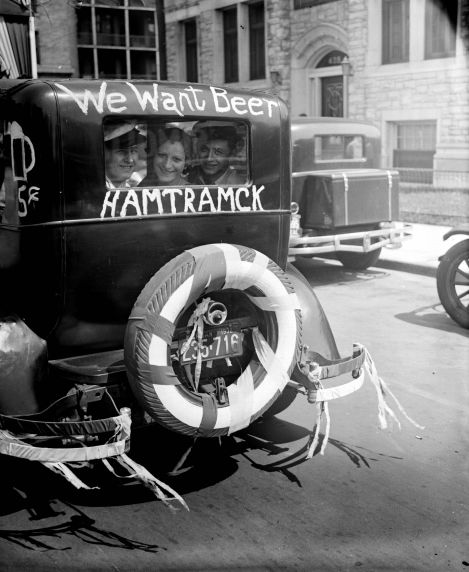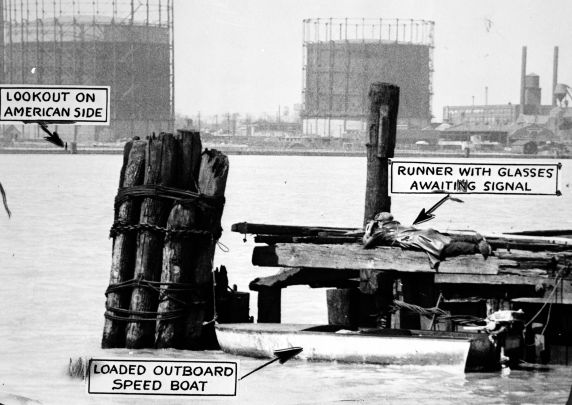Subject Focus: The Windsor-Detroit Funnel: Prohibition in Detroit
December 5th is Repeal Day, celebrating the end of Prohibition in the United States in 1933.
The Eighteenth Amendment to the United States Constitution was passed in 1919, prohibiting the sale, consumption, and manufacturing of alcoholic beverages. The National Prohibition Act (also known as the Volstead Act), defined what constituted an illegal alcoholic beverage and provided federal, state, and local authorities the regulations to enforce the prohibition of alcohol. Prohibition took effect in the United States on January 17, 1920, but in Michigan prohibition wasn't news.
Michigan church, business, and community leaders had been working to ban the sale of alcoholic drinks since 1852, believing that such a ban would reduce crime and improve both family life and employee productivity. Their campaigns succeeded in 1916, when the citizens of Michigan approved a prohibition amendment to the state constitution. Bootlegging operations and smuggling networks formed within hours of Michigan’s prohibition going into effect on May 1, 1917. Individual entrepreneurs could be seen with a bottle or two tucked under their coats, and professional smuggling rings brought contraband liquor from Toledo, where alcohol was still legal. Smugglers developed increasingly clever ways to outwit the police, and the threat of legal penalties did little to slow them down. The fines handed down to convicted smugglers were insignificant compared to the profits involved. However, the supply of alcohol from Ohio dried up in 1919 when that state passed its own prohibition laws.
With the supply of alcohol from Ohio cut off, bootleggers turned to Canada, which had favorable liquor laws. Smugglers began trafficking bootlegged liquor across the Canadian border and into Michigan via the Detroit River, Lake St. Clair, and other waterways between Michigan and Ontario, an area which became known as the “Windsor-Detroit Funnel.” When the rivers and lakes froze in the winter, smugglers simply drove across them or skated across the ice, dragging sleds full of whiskey behind.
By the time Prohibition took effect nationally, the residents of Michigan and Ontario were well versed in bootlegging, and they nearly perfected their trade during the next 13 years. Seventy-five percent of all the alcohol smuggled into the United States during Prohibition crossed the border at the Windsor-Detroit Funnel. By 1929 rumrunning was Detroit’s second largest industry, netting $215 million per year. Even more liquor was produced in illegal distilleries in the metro-Detroit area. While this bootlegged alcohol was distributed around the country, Detroit and its surrounding cities were kept particularly well-stocked; in 1928 the Detroit News estimated that there were between 16,000 and 25,000 speakeasies operating in the Detroit area. 
National legislators and law enforcement agencies initially underestimated how much liquor would flow over the border from Canada, and Michigan officials severely lacked the resources to stop the tide. They faced the additional problem that some community leaders and law enforcement officials were not entirely on board with Prohibition. The residents and officials of Hamtramck and Ecorse openly ignored the law. The Michigan State Police famously raided Detroit’s Deutches Haus -- operating as a speakeasy at the time -- and found 800 people inside, including a Michigan congressman, a sheriff, and Detroit Mayor John Smith.
Gangs began capitalizing on the smuggling trade in 1923, especially Detroit’s notorious Purple Gang. Violent crime increased as rival gangs fought for territory and profits, and the Collingwood Manor Massacre in 1931 truly shocked the city. As the extent of the smuggling problem became apparent, law enforcement agencies increased their efforts to stop the flow of alcohol. However, law-abiding citizens lost their patience with the authorities after having their property repeatedly raided and being harassed and shot at by overzealous water patrols while fishing and boating. Prohibition was intended to improve family life and reduce crime. Instead, a new and dangerous criminal class had developed.
Because of the lawlessness that Prohibition inspired, as well as the prospect of jobs that legal alcohol production could provide during the Great Depression, in 1933 Michigan reversed its own prohibition laws and, calling for the repeal of the 18th Amendment, the United States Congress sent the 21st Amendment to the states for ratification. Michigan was the first state to ratify the amendment, and Prohibition was officially repealed on December 5, 1933.
Visit the Prohibition in Southeastern Michigan image gallery to view scenes of Prohibition in Detroit, some of which were used in Ken Burns’ PBS documentary Prohibition. Records regarding the Purple Gang can be found in the Jewish Community Archives Leonard Simons Papers and the JCA Small Collections. Researchers can also make an appointment with the Reuther’s AV department to review our collection of images related to the Purple Gang, the Collingwood Manor Massacre, and to listen to tales of prohibition lore recorded as part of the Folklore Archive. For a more detailed account of Prohibition in Detroit, read Rumrunning and the Roaring Twenties: Prohibition on the Michigan-Ontario Waterway, written by Philip P. Mason, former director of the Reuther Library.
Troy Eller is the Archivist for the Society of Women Engineers.
- teller's blog
- Login to post comments
- Printer-friendly version


 Reddit
Reddit Facebook
Facebook LinkedIn
LinkedIn